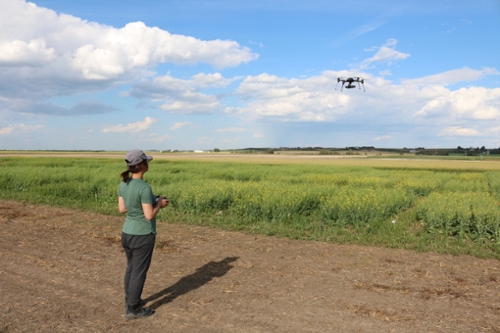
Profile: Ti Zhang
Unmanned Aerial Vehicles & Counting Canola Flowers
Ti Zhang, PhD Student in Phenotyping Canola (Project 1.2)
P2IRC Research: Counting Canola Flowers and Estimating Seed Yield Using UAV Images
Can you tell me a bit about yourself?
I was born in Chonqing city, China. When i was 15, I did a one-year international exchange as a student in Germany; this experience made me more aware of cultural differences. I completed my Bachelors of Science in Agriculture from Northwestern A&F University and then decided to come to Canada for further study on agronomy.
Can you give me a brief summary of your research?
Our main objective is to optimize yield estimation models in canola to enhance the selection process in plant breeding programs. My project uses unmanned aerial vehicles (UAVs) for imaging in order to select key traits (the phenotypes) of canola. These UAVs have various sensors on them to provide large quantities of field data in a short time. We are currently phenotyping canola in order to have a rough estimation of its number of flowers. Later on, more accurate estimation will be possible for final canola yield of parameters such as flower quantity, pod quantity, pod structure, canopy height, and pot moisture content. These growth parameters contribute to seed yield in canola. Developing digital phenotypes will help improve phenotyping accuracy, estimate canola yield, and ultimately help farmers produce higher yielding crops.
How did you become interested in your research?
I did my masters focused on herbicide research. Although my PhD project is quite different from my masters project, I think phenotyping is interesting and has worldwide applications.
This project involves cool technology with a very promising future. I believe many universities will want to build similar phenotyping labs and use UAVs in the near future.
Why is your project important?
If we develop the proper pipeline, this technology can be used by breeders, agronomists, and farmers. This technology is convenient and reduces time, travel, and labor-intensive tasks in the field. The high-throughput phenotyping method using UAVs provides new phenotyping methods and increases data accuracy compared with conventional phenotyping methods, especially for large-scale breeding programs.
Using UAVs for canola yield estimation will be used to determine agricultural input factors. Factors such as fertilizers, herbicides, fungicides, irrigation management, and agricultural practices (e.g. harvest, drying, and storage) can be planned or adjusted using UAV-based field scouting. Farmers can collect basic data on their fields and determine if their fields need something more, such as water, nutrients, herbicide, pesticide, etc. This reduces unnecessary economic input and increases net return for farmers and agricultural companies.
What was one of the biggest challenges you’ve faced as a researcher and how did you overcome it?
I’ve had two big challenges to overcome while working on the P2IRC project. The first is having to learn a brand-new area called remote sensing. I have a background in agronomy, so the computer stuff is all new to me. I have been learning basic coding (Python) in my field classes.
The second challenge for me is the amount of group work that we collaborate on in large groups across campus. It is a good experience to learn, as we have to communicate with many different people across different departments, such as computer sciences, soil sciences, and remote sensing.
What do you enjoy most about your research?
Combining computer work, technology, and field work - its practical.
How have you grown or developed as a professional because of your research?
This project is quite challenging and involves lots of learning. It requires wider and different knowledge - agronomy is my background, which is different from breeding.
This research involves multiple disciplines like breeding, soil science, computer science, remote sensing, and engineering. I have developed a better understanding of teamwork. I have also gained background and experience from working on new areas and collaborating with others with different areas of expertise. I have learned the importance of communication, patience, and origination. I am still working on my collaboration and organizational skills, and trying my best to be more patient when solving problems!
What do you like to do when you aren’t working on research?
In my spare time, I love travelling with family and friends, and photographing. Exploring new cultures and visiting different places is exciting and relaxing.
Research Gate: Ti Zhang


